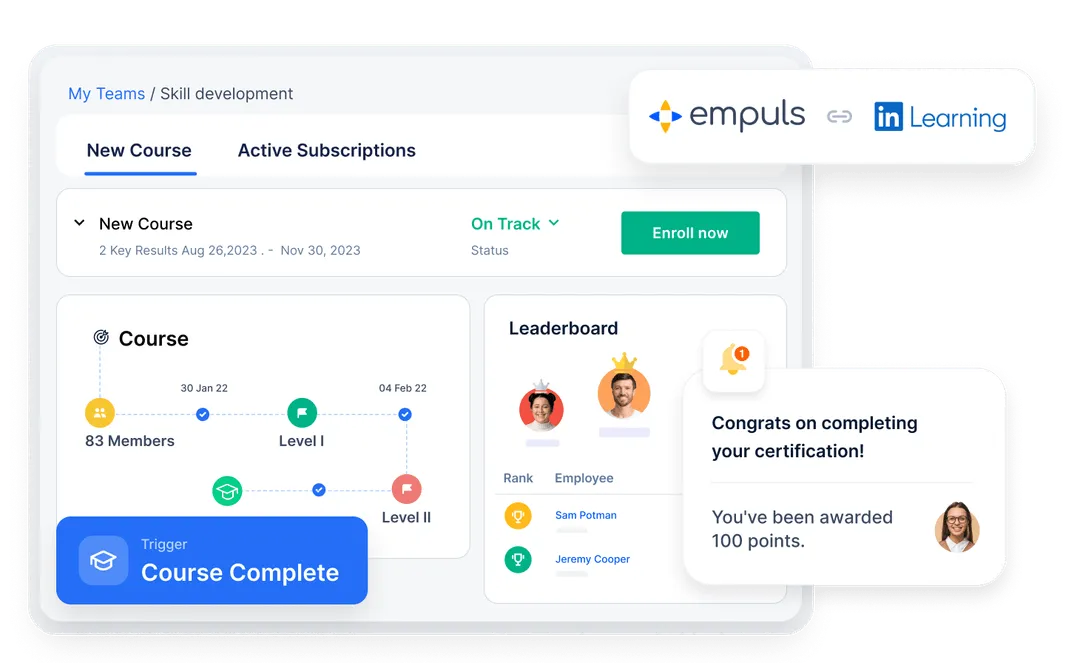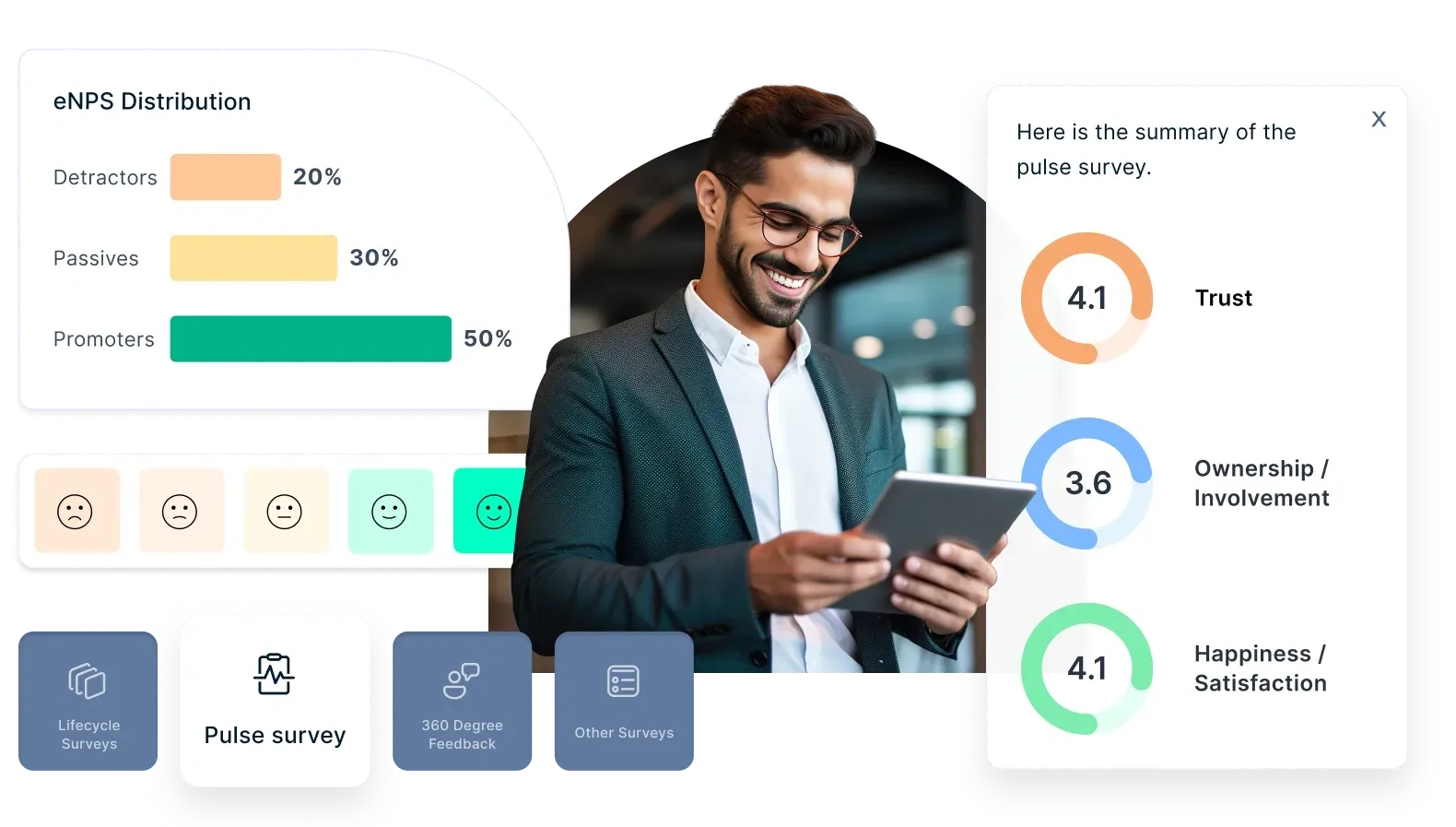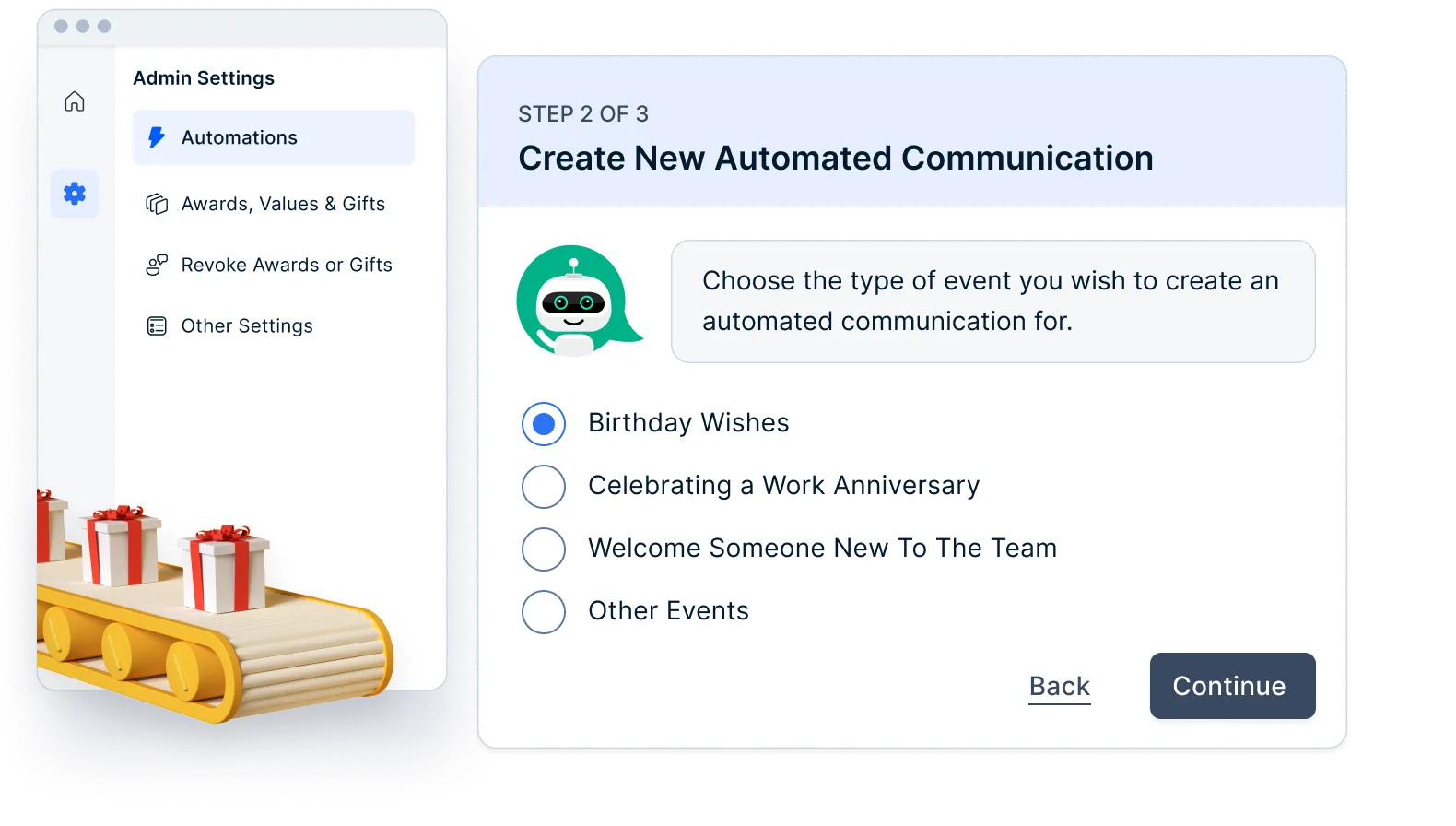في هذه الصفحة
إذا كان مقياس واحد يمكن أن يمثل نتائج جهود إدارة الأفراد في المؤسسة - فسيكون هذا المقياس هو رضا الموظفين. في حين أن مقاييس مثل الاستنزاف والتغيب عن العمل ضرورية لقياس صحة أنظمة إدارة الأفراد ، إلا أنها مؤشرات متأخرة لكفاءة الموارد البشرية.
For this very reason, employee satisfaction is also the most extensively studied occupational phenomenon globally. A well-designed and well-implemented employee satisfaction survey can predict turnover and aid to pre-empt it.
ما هو رضا الموظفين؟
رضا الموظفين يعني مدى رضا أو سعادة موظفيك بعملهم. إنه مستوى الرضا والحماس الذي يشعر به الموظفون تجاه عملهم.
تهدف هذه المقالة إلى فهم رضا الموظفين من وجهة نظر الثقافة التنظيمية ومحدداتها وكيفية قياسها بشكل فعال.
What drives employee satisfaction?
While organizations often focus on why employees leave, it's equally important to understand the factors that encourage them to stay. According to research, key elements that contribute to job satisfaction include:
- Meaningful work: Employees are more likely to remain in positions where they find the work engaging and aligned with their personal values.
- Recognition and rewards: Regular acknowledgment of achievements and fair compensation play crucial roles in employee retention.
- Career development opportunities: Access to training and clear paths for advancement motivate employees to commit long-term.
- Supportive management: Effective leadership that fosters open communication and provides support enhances job satisfaction.
- Positive work environment: A culture that promotes collaboration, respect, and work-life balance contributes to higher retention rates.
By focusing on these aspects, organizations can create jobs with the highest satisfaction, leading to reduced turnover and a more committed workforce.
رضا الموظفين والثقافة التنظيمية
في كتابه "الثقافة المتغيرة للمصنع" ، صاغ الدكتور إليوت جاك أول ذكر للثقافة من منظور منظمة في عام 1951. في يومه ، كان هذا الكتاب يهدف إلى استكشاف مجموعة القيم التي تحتاج المنظمات إلى رعايتها للحصول على التزام كامل من موظفيها.
He invented the term' requisite organization' that he defined as an organization 'with a list of organizational values' that achieves 'doing business with efficiency and competitiveness' by 'release of trust and satisfaction in its employees.
Trust and satisfaction have since been constant evaluation subjects for people management. The requisite organization theory proves that organizational culture is a controllable determinant that affects employee satisfaction.
Eventually, a myriad of research studies in the 1990s and the 2000s proved a clear statistical correlation between Employment Satisfaction and Organizational culture. Ivana Petrovic's 2016 exploratory study identified nine organizational factors that lead to job satisfaction.
فيما يلي تسعة عوامل والفئات الفرعية للجوانب التي تمت تغطيتها أثناء الدراسة:
العامل 1: ظروف العمل
- توافر المعلومات اللازمة لأداء العمل بشكل جيد.
- غياب التوتر والضغط على الموظفين.
- تنظيم عمل واضح مع التقسيم الدقيق لمهام العمل.
- ظروف عمل آمنة.
- ظروف العمل المادية.
- التقييم الموضوعي للأداء الفردي.
- غياب التوتر والضغط في العمل.
- الترويج على أساس معايير واضحة ومعروفة.
- احترام حقوق الموظفين.
- مهام ومسؤوليات عمل محددة بوضوح.
- فرصة لاتخاذ المبادرة في العمل.
- معايير عادلة في تحديد الرواتب.
العامل 2: العلاقات بين الزملاء في العمل
- جو ودي في العمل.
- التواصل الجيد بين الزملاء.
- علاقات جيدة بين الزملاء.
- الدعم المقدم من الزملاء.
- عدم وجود تعارض بين الموظفين.
- زملاء أكفاء وموثوقون.
- غياب التوتر والضغط على الموظفين.
- المساعدة والدعم من المديرين في أداء مهام العمل.
العامل 3: الوظيفة نفسها
- وظيفة صعبة ومثيرة.
- وظيفة محفزة مع عدد قليل من المهام الروتينية.
- فرص السفر إلى الخارج للعمل.
- محتوى الوظيفة ، الأنشطة داخل العمل.
- فرصة لاتخاذ المبادرة في العمل.
- فرص التطوير المهني والتدريب.
العامل 4: أهمية الشركة
- شركة في مجال عمل مهم للمجتمع.
- الصورة العامة للشركة وسمعتها.
- درجة عالية من الانضباط.
- إبلاغ الموظفين بالوضع العام في الشركة.
- إبلاغ الموظفين عن الأخبار في أجزاء مختلفة من الشركة.
- فرص للحصول على فوائد مختلفة.
العامل 5: المديرون
- مديرين ذوي كفاءة عالية.
- المديرون الذين يحترمون الموظفين ومنفتحون على اقتراحاتهم.
- مهارات تنظيمية جيدة للمدير.
- توافر المدير لمرؤوسيه.
- المساعدة والدعم من المديرين في أداء مهام العمل.
العامل 6: نظام التعويض
- نظام التعويضات الذي تعتمد فيه رواتب الموظفين على مستوى خبرتهم.
- نظام تعويض لا يميز وفقا لجزء المنظمة التي يعمل فيها الموظف.
- نظام التعويض الذي تعتمد فيه الرواتب فقط على النتائج المحققة.
- راتب مساو للجهد المستثمر.
- معايير عادلة في تحديد الرواتب.
العامل 7: مكافأة النتائج وتهيئة الظروف لتحقيقها
- نظام التعويض الذي تعتمد فيه الرواتب فقط على النتائج المحققة.
- معايير عادلة لتحديد الأجور.
- نظام التعويض الذي تعتمد فيه الرواتب على مستوى الخبرة.
- راتب مساو للجهد المستثمر.
- نظام تعويض لا يميز وفقا لجزء المنظمة التي يعمل فيها الموظف.
- مقدار الراتب.
- الترويج على أساس معايير واضحة ومعروفة.
- فرص للنمو المهني والتدريب.
- التقييم الموضوعي للأداء الفردي
- تدريب تمهيدي عالي الجودة.
- تقدير واعتراف من قبل المديرين بعمل جيد.
- تنظيم عمل واضح مع التقسيم الدقيق لمهام العمل.
- التعاون الجيد بين الوحدات التنظيمية المختلفة.
العامل 8: الشركة كدعم
- شركة يمكن للموظفين الاعتماد عليها إذا وقعوا في مشكلة
- فرص للحصول على فوائد مختلفة.
- تهتم الشركة بموظفيها.
- ظل الموظفون على اطلاع بالوضع العام في الشركة.
- شركة في مجال عمل مهم للمجتمع.
- الصورة العامة للشركة وسمعتها.
- يتم تعريف احترام حقوق الموظفين في عقد العمل الجماعي.
- إعلام الموظفين بالأخبار في أجزاء مختلفة من الشركة.
- وظيفة لا تتطلب العمل الإضافي.
العامل 9: ظروف العمل الأساسية
- ظروف عمل آمنة.
- ظروف العمل المادية.
- توافر أصول ومعدات العمل اللازمة.
- توافر المعلومات المطلوبة لأداء عمل جيد.
Apart from these, following are a fact about employee’s personal attributes as well that helps in employee satisfaction.
السمات الشخصية للموظف ورضا الموظفين
بينما تؤثر الثقافة التنظيمية على رضا الموظفين ، فإن رضا الموظفين هو محدد آخر. خلال بحثهما في عام 1993 ، وجد براون وبيترسون أنه بالإضافة إلى الثقافة كمتغير تنظيمي ، فإن السابقة الأخرى للرضا هي خصائص الموظفين وتصورات أدوارهم.
بعد 13 عاما ، في عام 2006 ، أنشأ ماركوس كريستن وغانيش آير وديفيد سوبرمان نموذجهم للرضا الوظيفي. هذه واحدة من أكثر الدراسات البحثية التنظيمية المشار إليها والمعيارية حول رضا الموظفين. يهدف هذا النموذج إلى توضيح الغموض المحيط بمفاهيم علاقات العمل وتوحيد جميع الدراسات المستقلة المتعلقة بذلك.
تحدث نموذج الرضا الوظيفي هذا عن كيفية ارتباط مفاهيم علاقة العمل ببعضها البعض.
It proved the following correlations between job performance, job satisfaction, (individual’s) efforts, (individual’s) ability, company productivity, job factors, role perception, and compensation:
- تأثير الأداء الوظيفي على الرضا الوظيفي للموظف إيجابي ومهم للغاية.
- يزداد الأداء الوظيفي مع زيادة الجهود و / أو زيادة عدم قدرة الموظف.
- تزداد إنتاجية الشركة مع الأداء الوظيفي.
- يرتبط الجهد سلبا بالرضا الوظيفي.
- يرتبط التعويض ارتباطا مباشرا وكبيرا بالرضا الوظيفي.
- تؤثر عوامل العمل الإيجابية بشكل إيجابي على الجهد والرضا الوظيفي.
- تصورات الدور الإيجابية تؤثر إيجابا على الجهد والرضا الوظيفي
كيفية زيادة الرضا الوظيفي في مكان العمل؟
فيما يلي اثنتا عشرة طريقة لزيادة الرضا الوظيفي بغض النظر عن الاختلافات بين الوظيفة والمهنة.
1. وضع توقعات واضحة
A survey by Gallup revealed that only 26% of employees felt they could maintain a healthy work-life balance. Ensure that your employees are not overworked, stressed, or overwhelmed as a manager. Be it a job or career, be mindful of your assigned tasks, even if you lead an ambitious team.
When employers regularly conduct employee engagement and lifecycle surveys, they get to gauge the employee’s pulse. Empuls allows organizations and HR teams to configure surveys for the employee lifecycle, including onboarding, wellness, learning, and exit.
يمكنك أيضا تعيين الأسئلة وإخفاء الهوية والجمهور لتحديد المخالفات والمناطق التي تحتاج إلى الاهتمام. تساعد النصائح القائمة على البيانات للتحسين القادة والمديرين على التصرف بشكل استباقي
2. التعرف على العمل الجيد
يجب أن يستغرق المديرون بعض الوقت لجعل أعضاء الفريق يشعرون بأنهم مرئيون وموضع تقدير. تذكر أن تحتفل بالانتصارات الصغيرة والإنجازات الكبيرة وتقدم ردود فعل إيجابية.
Even during remote working, you should brainstorm ways to appreciate and recognize employees for their work authentically. The reason is that most employees don’t feel they get enough praise. Leaders have an enormous scope to make employees proud of their work.
Workplace Intranet, Empuls allows managers to give the team and individual praise. Consider specifying the task, project, and impact your employee had, which made you recognize and celebrate the good work.
تحفز شركة Hewlett Packard Enterprise (HPE) موظفيها من خلال الاعتراف علنا بمساهمتهم في الشركة على وسائل التواصل الاجتماعي.
3. التركيز على الأهداف طويلة الأجل
عندما يكون لدى الفرق والموظفين رؤية واضحة لأهداف المؤسسة ورؤيتها واستراتيجيتها على المدى الطويل ، يمكن للموظفين التواصل مع الأهداف. يمكنهم فهم كيف يمكنهم المساهمة في تحقيق العين ، مما يؤدي إلى زيادة الرضا الوظيفي.
اجعل أعضاء فريقك يشعرون بأنهم جزء من الصورة الأكبر. أظهر لهم أنك تقدر مدخلاتهم من خلال دعوة تعليقاتهم.
4. لديك قناة اتصال مفتوحة
Constant communication is crucial for building relationships in a job and career. Open communication ensures that important information does not get missed. Lead by example when creating a culture of open and honest communication.
بصفتك مديرا ، عندما تنقل مشاعرك ، يشعر الآخرون بالأمان في التعبير عن مشاعرهم. في جميع الأوقات ، قم بتوفير رؤية للمعلومات التي لديك.
تحقق بشكل متكرر مع فريقك للبقاء على اتصال شخصيا ومهنيا. ميزة الإنترانت الاجتماعية من Empuls يساعد على إزالة الصوامع ويبقي الجميع على اتصال. بهذه الطريقة ، يمكن للقادة والمديرين مواءمة الموظفين مع هدف مشترك وأخبار ومعلومات
5. اهتم برفاهية موظفيك
سواء كانت وظيفة أو مهنة للموظف ، فإن إحدى الطرق لزيادة تحفيز الموظفين هي إظهار أنك تهتم حقا برفاهيتهم. ويشمل ذلك تحفيزهم على تحقيق معالم لياقتهم البدنية وحتى تشجيعهم على قطع الاتصال عندما يشعرون بالإرهاق.
شجع المديرين على التحقق من الفريق باستخدام 1 على 1 لبناء اتصال ذي مغزى قبل القفز إلى مناقشة العمل. سيكون الموظفون الأصحاء والسعداء فعالين وراضين.
6. منحهم فرصا للتعلم
عندما يتوقف الموظفون عن التعلم ، سيفكرون في تغيير الوظيفة للتحفيز. يجب على المديرين تشجيع الموظفين على صقل مهاراتهم من خلال حضور المؤتمرات والندوات عبر الإنترنت والأحداث. حافظ على عقلية الفضول والتعلم عالية للمتدربين الذين يقومون بعمل والموظفين الذين يبنون مهنة.
ميزة الاتصال والمحاذاة Empuls تمكنك من التحدث مع الموظفين حول أهدافهم وغاياتهم. عندما تعرف ما يريدون التركيز عليه ، امنحهم المعلومات والموارد والتدريب الوظيفي لتحسين المهارات.
The Connect and Align feature of Empuls allows you to engage with employees about their goals and aspirations. Once you understand their focus areas, provide them with the necessary information, resources, and job training to support their upskilling.

Whether they are completing a training module, earning a new certification, or mastering a complex skill, motivate and incentivize them to invest in their professional and personal growth.
With personalized rewards and recognition, organizations can empower employees to take charge of their learning journey, fostering excellence and driving both individual and organizational success.
7. مشاركة الملاحظات بشكل متكرر
سواء كان الموظف يعتبر عمله وظيفة أو مهنة ، فإنه يتوق إلى ردود الفعل. هذا يمكن أن يساعدهم على أن يكونوا أكثر كفاءة ، والعمل بشكل أكثر ذكاء وتحسين الأداء. عندما تقدم ملاحظات بناءة ، سيقدرون الوقت والجهد الذي تبذله. تأكد من صياغة ملاحظاتك ومدخلاتك بشكل صحيح ليتم استقبالها بشكل جيد.
جلسات التغذية الراجعة البناءة والصحية ، التي تتم شهريا أو كل ثلاثة أشهر ، مثالية.
8. قياس المشاركة ورضا الموظفين
المفتاح هو استضافة استطلاعات النبض أو eNPS بشكل متكرر. لم تعد الاستطلاعات السنوية كافية. يتطلب تحسين ثقافة الشركة اتباع نهج رشيق.

Pulsate with Empuls
Empuls has pulse surveys that help managers measure real-time employee engagement through eNPS. Listening and understanding employee feedback helps in turning it into actionable insights.
9. خصومات الموظفين
خصومات الموظفين هي ميزة حاسمة يقدرها الجميع. يمكن أن تكون في شكل صفقات هائلة للفريق على الأدوية والملابس والبقالة والبضائع.
سواء كانت وظيفة أو مهنة ، فإن هذه الخصومات والمكافآت تقلل من الاستنزاف وتحسن الإنتاجية. فهي تمنح القوى العاملة لديك ميزة إضافية للعمل معك.
Microsoft gives a range of perks listed on its career page to help employees live healthy lives.
10. تعزيز العلاقات من أجل تعاون أفضل
سواء كانت وظيفة مؤقتة لموظف أو مهنة ، فإن وجود علاقات إيجابية يدفع الرضا الوظيفي العام. يمكن للمديرين اتخاذ خطوة إلى الأمام وتشجيع الموظفين على الترابط حول الهوايات الشائعة حتى خارج العمل.
بعد كل شيء ، فإن العلاقات القوية والجديرة بالثقة تغذي تعاونا أفضل وتبني ثقة الفريق. عندما يعمل الناس معا بشكل أفضل ، فإن العمل يعمل أيضا بشكل أفضل. تسهيل اتصالات أفضل بين الأشخاص في فريقك.
11. توفير مسار وظيفي طويل الأجل
ساعد موظفيك على التخطيط لنجاحهم على المدى الطويل. هذا يدل على أنك ملتزم برؤيتهم يتقدمون ، وأنك على استعداد للاستثمار في نموهم الوظيفي. ساعدهم على تحديد أهدافهم المهنية للانتقال من وظيفة إلى أخرى.
12. المكافآت والتقدير ومكافأة الأداء
في حين أن الرواتب الشهرية على ما يرام ، تحدث أشياء عظيمة عندما تكون المكافآت والتقدير في الكتب. هناك علاقة مباشرة بين المكافآت والزيادة في الجهود والنتائج. بالنسبة للقوى العاملة المتحمسة ، اربط أدائها بالمكافآت المالية وأشركها في إنجاز المهام بكفاءة.
The importance of performance bonuses is highlighted by IRF, which found team incentives to increase productivity by as much as 44%.
Using Empuls, you can automate the process of rewards and recognition to build a culture of appreciation. Empuls simplifies rewards and recognition by automating the process, ensuring a seamless and engaging experience for employees.

- Custom workflows: Automate awards in employee recognition programs with structured workflows.
- Flexible approval processes: Include nominators, moderators, jury panels, or multiple approvers for a fair and transparent system.
- Recognition triggers: Set up automated recognition for special events and milestones, ensuring timely appreciation.
By leveraging automation, Empuls helps organizations create a culture of appreciation, boosting job satisfaction and fostering a motivated workforce.
How to measure employee satisfaction?
Measuring employee satisfaction effectively helps organizations identify areas for improvement and maintain high levels of job satisfaction. Below are several proven methods:
Employee job satisfaction survey
Conducting regular employee job satisfaction surveys is one of the most effective methods to assess how satisfied employees are with their roles, management, work environment, and overall company culture. Surveys can identify strengths and highlight areas requiring attention, guiding actionable strategies for improvement.
One-on-one meetings and feedback sessions
Regularly scheduled one-on-one meetings allow for candid discussions about employees' satisfaction levels. Managers can directly gauge how employees feel about their roles, workload, and professional growth opportunities, providing insights that might not surface in broader surveys.
Analyzing employee turnover and retention rates
High turnover or declining retention rates often indicate low job satisfaction. Regular analysis of these metrics can help management understand underlying issues and promptly address factors contributing to dissatisfaction.
Evaluating productivity and engagement levels
Engaged and productive employees typically experience high job satisfaction. Monitoring productivity, quality of work, and participation in company activities provides indirect indicators of satisfaction levels.
Exit interviews
Exit interviews can provide candid insights into why employees choose to leave, highlighting potential issues related to job satisfaction. This information helps organizations proactively make necessary changes to retain existing talent.
By consistently applying these measurement strategies, businesses can ensure sustained high job satisfaction, positioning themselves to foster an engaged, motivated, and successful workforce.
استنتاج
Whether the employment is a job or a career, the best leaders and managers improve employee engagement, motivation, and overall job satisfaction. An employee engagement software such as Empuls can assist in uncovering employee insights to pull the right engagement drivers to build a highly engaged workforce.
واختتم بالكلمات الذهبية لهنري فورد من القرن الماضي التي تحمل حتى الآن ، "سواء كنت تعتقد أنك تستطيع ، أو تعتقد أنك لا تستطيع ، فأنت على حق. كل شيء يبدأ بفعل ما هو ضروري، ثم ما هو ممكن، وفجأة تفعل المستحيل".
الأسئلة الشائعة
1. Which four sources contribute to job satisfaction?
The four key sources of job satisfaction are:
- Work environment – A positive and supportive workplace.
- Compensation and benefits – Fair pay and perks.
- Job role and responsibilities – Meaningful and fulfilling tasks.
- Work-life balance – Flexibility and manageable workload.
2. What is the meaning of job satisfaction?
Job satisfaction refers to the level of contentment employees feel about their work, which affects their motivation, performance, and overall well-being.
3. What are the seven dimensions of job satisfaction?
The seven dimensions include:
- Pay and benefits
- Work conditions
- Job security
- فرص النمو الوظيفي
- التوازن بين العمل والحياة
- Relationship with colleagues
- Management and leadership support
4. What are the six major sources of job satisfaction?
The six major sources are:
- Compensation and benefits
- بيئة العمل
- Job security
- Career growth and development
- الاعتراف والتقدير
- التوازن بين العمل والحياة













